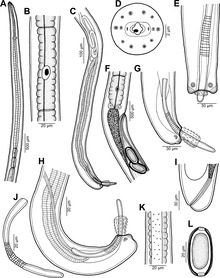
The Trichocephalida is an order of parasitic nematodes.
Capillaria philippinensis is a parasitic nematode which causes intestinal capillariasis. This sometimes fatal disease was first discovered in Northern Luzon, Philippines, in 1964. Cases have also been reported from China, Egypt, Indonesia, Iran, Japan, Korea, Lao PDR, Taiwan and Thailand. Cases diagnosed in Italy and Spain were believed to be acquired abroad, with one case possibly contracted in Colombia. The natural life cycle of C. philippinensis is believed to involve fish as intermediate hosts, and fish-eating birds as definitive hosts. Humans acquire C. philippinensis by eating small species of infested fish whole and raw.
Capillaria plica is a parasitic nematode which is most often found in the urinary bladder, and occasionally in the kidneys, of dogs and foxes. It has also been found in the domestic cat, and various wild mammals. Its presence usually produces no clinical symptoms, but in some cases, it leads to hematuria, cystitis, or difficulty in urination.

Capillaria hepatica is a parasitic nematode which causes hepatic capillariasis in rodents and numerous other mammal species, including humans. The life cycle of C. hepatica may be completed in a single host species. However, the eggs, which are laid in the liver, must mature outside of the host body prior to infecting a new host. Death and decomposition of the host in which the adults reach sexual maturity are necessary for completion of the life cycle.

Capillaria is a genus of nematodes in the family Capillariidae .
Capillariasis is a disease caused by nematodes in the genus Capillaria. The two principal forms of the disease are:
Myleusnema bicornis is an intestinal parasite of Myleus ternetzi, or "Ternetz's Silver Dollar", a freshwater Characoid fish commonly found in the French Guiana river. M. bicornis has several unusual morphological characteristics, namely the two postcloacal "horns" in the posterior of males, and a separate elongated cephalic region (head) that may be extended and retracted. These features differ vastly from other Cosmocercoidean nematodes, as well as any others within the family Kathlaniidae, and as such necessitate the creation of the new genus Myleusnema; however, no genetic taxonomic studies have been performed.

Paracapillaria is a genus of parasitic nematodes. Species of the genus Paracapillaria parasitise fishes and amphibians, reptiles (snakes), and a single species, Paracapillaria philippinensis(Chitwood, Velasquez & Salazar, 1968), is known from birds and mammals including man.

Huffmanela is a genus of parasitic nematodes, belonging to the family Trichosomoididae.

The Trichosomoididae is a family of nematodes.

Huffmanela hamo is a parasitic nematode. It has been observed in the muscles of the dagger-tooth pike conger Muraenesox cinereus, a muraenesocid marine fish off Japan. Its life-cycle is unknown.
Philometra sphyraenae is a species of parasitic nematode of fishes, infecting the gonads of marine perciform fishes off the eastern Indian coast. It was first found in the pickhandle barracuda, Sphyraena jello. It is distinguished from its cogenerates by the gubernaculum structure in males, as well as the shape and structure of the females' cephalic and caudal ends, and their oesophagus.

Cucullanus is a genus of parasitic nematodes. The genus includes more than 100 species.

František Moravec is a Czech parasitologist who specialises on the Nematodes, especially the nematodes parasites of fishes. His research is mainly in the field of taxonomy of the Nematoda.

Cystidicolidae is a family of spirurian nematodes. It was described by Skrjabin in 1946. All members of the family are parasites of fish.

Jean-Lou Justine, French parasitologist and zoologist, is a professor at the National Museum of Natural History in Paris, France, and a specialist of fish parasites and invasive land planarians.

Ascarophis is a genus of parasitic nematodes, belonging to the family Cystidicolidae. Species of Ascarophis are parasitic as adults in the gastrointestinal tract of marine and estuarine fishes.

Moravecnema is a genus of parasitic nematodes, belonging to the family Cystidicolidae. Species of Moravecnema are parasitic as adults in the gastrointestinal tract of fish. According to the World Register of Marine Species, the genus currently (2019) includes a single species, Moravecnema segonzaci, which is a parasite in a deep-sea fish.
Prospinitectus is a genus of parasitic nematodes, belonging to the family Cystidicolidae. Species of Prospinitectus are parasitic as adults in the gastrointestinal tract of Tuna fish.

Ichthyofilaroides is a genus of parasitic nematodes, belonging to the family Guyanemidae Petter, 1974.












